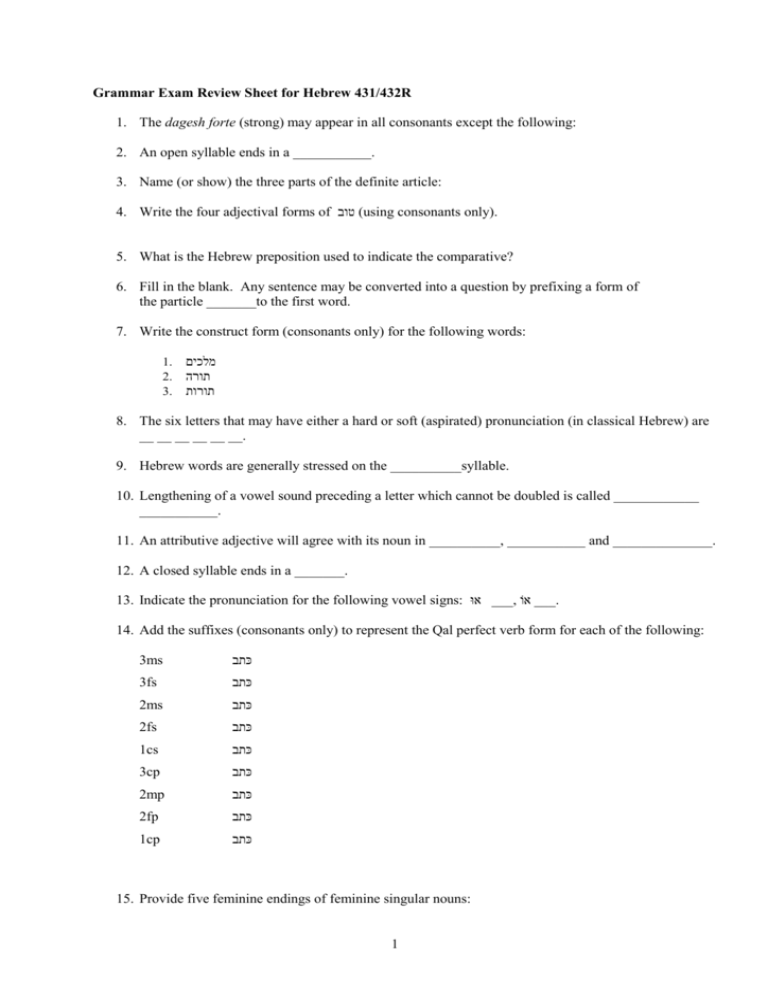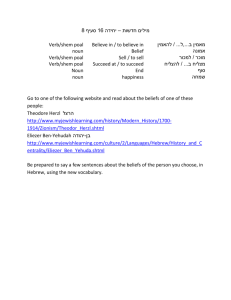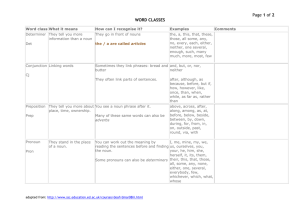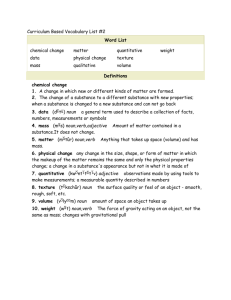October 6, 2006
advertisement

Grammar Exam Review Sheet for Hebrew 431/432R 1. The dagesh forte (strong) may appear in all consonants except the following: 2. An open syllable ends in a ___________. 3. Name (or show) the three parts of the definite article: 4. Write the four adjectival forms of ( טובusing consonants only). 5. What is the Hebrew preposition used to indicate the comparative? 6. Fill in the blank. Any sentence may be converted into a question by prefixing a form of the particle _______to the first word. 7. Write the construct form (consonants only) for the following words: 1. 2. 3. מלכים תורה תורות 8. The six letters that may have either a hard or soft (aspirated) pronunciation (in classical Hebrew) are __ __ __ __ __ __. 9. Hebrew words are generally stressed on the __________syllable. 10. Lengthening of a vowel sound preceding a letter which cannot be doubled is called ____________ ___________. 11. An attributive adjective will agree with its noun in __________, ___________ and ______________. 12. A closed syllable ends in a _______. 13. Indicate the pronunciation for the following vowel signs: ___ אּו, ___ אֹו. 14. Add the suffixes (consonants only) to represent the Qal perfect verb form for each of the following: 3ms ּכתב 3fs ּכתב 2ms ּכתב 2fs ּכתב 1cs ּכתב 3cp ּכתב 2mp ּכתב 2fp ּכתב 1cp ּכתב 15. Provide five feminine endings of feminine singular nouns: 1 16. What are the three functions of the preposition ?מן ִ 17. Add the consonants to the preposition lamed to represent the pronominal suffixes listed below: 1cs 2ms 2fs 3ms 3fs 1cp 2mp 2fp 3mp 3fp ל ל ל ל ל ל ל ל ל ל 18. Translate into Hebrew (using consonants only): “the voice of the prophet” “a voice of a prophet” “a voice of the prophet” 19. What is the Hebrew character that forms a directional suffix (added to some nouns to indicate direction towards)? 20. When two shewas occur together in the middle of a word as in יִ ְׁש ְׁמרּוthe first shewa closes the one syllable and is therefore _______(vocal or silent?), while the second begins the next syllable and is therefore ______(vocal or silent?). 21. Name the four prefixes that are attached to the imperfect form of the verb: 22. Put כֹ תֵ בin its four participial forms (i.e., m.s., f.s., m.p., and f.p.): 23. Give an example of a segholate noun. 24. Do segholate nouns have an ultimate or penultimate stress? 25. The dagesh lene (weak) may appear only in which six Hebrew letters ___________. 26. The dot in the he ( )הin “( סּוסּהher horse”) is called _______. 27. What is the normal word order in the verbal sentence? 28. Which four Hebrew consonants “are so feeble (in pronunciation) that, under certain conditions, they lose their consonantal character and quiesce” (quiescent-- become silent) or coalesce? ___ ___ ___ ___ 29. Show the three forms of the composite shewa. 30. Which four Hebrew consonants take a composite shewa instead of a vocal shewa? ___ ___ ___ ___ 2 31. Demonstrate how propretonic reduction works by forming the plural (either masculine or feminine) of דָּ בָּ ר. Which two vowels consistently reduce with propretonic reduction? 32. Explain pretonic reduction. 33. When should the qametz (ָּ) be pronounced as a long “o” sound (i.e., ;כָּלpronounced as kol and not kal)? 34. What are the three inseparable prepositions? 35. Provide an example of a masculine plural noun that ends in ֹות-. 36. Provide and example of a feminine plural noun that ends in ים.-. 37. A closed unaccented syllable must have a _______ vowel. 38. The stress ______(never or always?) occurs on the syllable second before the last (the antepenultimate). 39. The stressed syllable is often referred to as the ________syllable, and the two preceding it as the ___________ and _______________respectively (use any of the following vocabulary—tonic, penultimate, ultimate, antepenultimate, propretonic, pretonic) 40. What are the three volitional forms in Biblical Hebrew? 41. The infinitive construct is negated with ____________. 42. The most frequent use of the infinitive construct is with the three inseparable prepositions ___ ___ ____. 43. Add the consonants to represent the pronominal suffixes listed below: 1cs סּוס 2ms סּוס 2fs סּוס 3ms סּוס 3fs סּוס 1cp סּוס 2mp סּוס 2fp סּוס 3mp סּוס 3fp סּוס 3 44. Add the prefixes and suffixes (consonants only) to represent the Qal imperfect verb form for each of the following: 3ms כתב 3fs כתב 2ms כתב 2fs כתב 1cs כתב 3mp כתב 3fp כתב 2mp כתב 2fp כתב 1cp כתב 45. When using the number “two” to modify nouns, does it stand before or after the plural noun it modifies? [both] 46. The masculine form of numbers three through ten are used/are not used with the feminine noun. 47. The feminine form three through ten are used/are not used with the masculine noun. 48. How is the distributive usually formed (i.e., year by year, two by two)? 49. Do both ordinals (first, second, third, etc.) and cardinals (one, two, three, etc.) have feminine and masculine forms in Hebrew? Answer: Yes 50. What is the symbol for the pausal form called sof pasuq (end of verse)? 51. What is the symbol for the pausal form called athnah? 52. What do the words ketib and qere denote? 53. What is the most common symbol that denotes the qere and where is it situated (i.e., in the margins, the body of the text, or elsewhere)? Answer: The symbols are 1. a qof, which serves as an abbreviation for qere; 2. the word qere; 3. the expression qere wela’ ketib (“read but not written”) designates a word that is read but not written; the text includes the vocalization but not the consonants (e.g., Jdg. 20:13; Ruth 3:17; 2 Sam. 8:3; Jer. 31:38). 4. ketib vela’ qere (“written but not read”, i.e., ignore the word that is written) designates a word that is written but not read; the consonants are included but without vocalization (e.g., Ruth 3:12; 2 Sam. 13:33; Jer. 51:3) 4 54. What are the three most prominent qere perpetuum (perpetual qere) readings? Answer: The qere perpetuum readings include the 1) Tetragrammaton, 2) the proper name Jerusalem, and in some Pentateuchal manuscripts 3) the pronoun הואpronounced as היא. 55. Provide three reasons for the existence of the ketib-qere readings. Answer: Here are five reasons: 1) To present a different spelling 2) To preserve variant readings 3) To avoid voicing the Tetragrammaton 4) For euphemistic purposes 5) To correct a textual error 56. What is the large Masorah (Masorah magna) and where is it situated on a page of BHS? 57. What is the small Masorah (Masorah parva) and where is it situated on a page of BHS? 58. What is the critical apparatus and where is it situated on a page of BHS? 59. What letters are the matres lectionis (“mothers of reading”)? Note the singular: mater lectionis “mother of reading.” 60. In addition to serving as consonants, what is the function matres lectionis? Answer: They are markers of vowels. Yod marks hireq, segol, or tsere; Vav marks holem or shureq; and He marks qamets, segol, tsere, or holem. Yod and vav may serve as matres at the end or in the middle of a word; He may be serve as a mater only at the end of a word. 61. What are the four chief historical stages of classical Hebrew orthography? Answer: (Lambdin xxiii) 1. [The earliest inscriptions (circa 10th century B.C.) lacked vowels and matres lectionis. Therefore מלךmay have been read as king, queen, he ruled, he will rule, ruling, they ruled, and so forth (see Lambdin xxiii). 2. During the pre-Exilic era, or from the 9th to 6th centuries B.C., the matres lectionis were employed to indicate final vowels. 3. During the post-Exilic era (from 587 B.C.) the yod and waw were used to indicate vowels within a word. 4. Sometime around the 9th or 10th centuries A.D. the Masoretes perfected the vowel system (which had been used in some form for centuries). This is the vowel system used in the present Masoretic Text. 5 62. What is the difference between full (plene) and defective spelling? Answer: When a word employs a mater lectionis it has a full spelling (i.e., דוידDavid); when it lacks a mater lectionis, it is defective (i.e., דודDavid). There is no difference in meaning between defective and full spellings. Compare color, neighbor, Savior (American) versus colour, neighbour, Saviour (British). 63. What is an initial letter? medial? final? 64. What is the mappiq and what is its function? 65. What is the most common syntax of a verbal clause in prose texts? Answer: 1. Circumstance, i.e., adverbs or words that provide the narrative in context, i.e., then, at that time, after these events, then, now, moreover, etc. 2. Verb 3. Subject (if any). “Since the subject of a verb is often indicated in the verb itself, it is possible that neither a noun nor independent pronoun may be stated. When a noun is explicitly named as a subject, however, it ordinarily comes after the verb” (Seow, 149). 4. Indirect object 5. Direct object Example: 1. At that time 2. gave 3. the Lord 4. to you 5. the land. 66. What are some characteristics of Hebrew poetry? Answer: 1. Longer forms of prepositions are employed i.e., ( עַל = ֲעלֵיGesenius (2006), pg. 15). 2. The following particles (frequently found in prose) are less frequent in poetry: 1) The relative pronoun ()אֲשֶׁ ר 2) The definite article ( ַ)ה. 3) The definite direct object marker ()אֶׁ ת. 3. Irregular hireq yod (hireq compaginis) or holam waw (waw compaginis) is attached to the construct noun, e.g., “ עֹ זְׁבִ י הַ צ ֹאןthe deserter of the flock” (Zech. 11:17), where we would expect עֹ זֵב הַ צ ֹאן. The translation value remains the same. 4. 3mp pronominal suffix is sometimes longer in poetry than prose. Poetry= ָּמֹוprose = ָּם. (Gesenius (2006), pg. 15) 5. “Double duty” preposition. Often in poetry a preposition that is attested in line one of a parallelism serves a noun in the second line, although that preposition is not attested in the second line, e.g., Isa. 48:14: “he will do his will against Babylon and his arm shall be (against) the Chaldeans ּוזְׁרֹעֹו ּכ ְַׁש ִדים,( ַיעֲשֶׁ ה חֶׁ פְׁ צֹו בְׁ בָּ בֶׁ לNote that Chaldeans does not have a preposition). 67. Collective nouns (i.e., people )עַםmay take/may not take either the plural or singular verb. Answer: they may take: E.g., “The people went” (either ַויֵלְׁ כּו הָּ עָּםor ַויֵצֵ א הָּ עָּם.] 6 68. When two or more nouns serve as the subject, the verb may/may not be singular or plural. Answer: they may be singular or plural: E.g., “and Aaron and Moses went” ַו ָּיב ֹא מֹשֶׁ ה וְׁ אַ הֲרֹ ןor "and Aaron and Moses gathered" ַויַקְׁ הִ לּו מֹ שֶׁ ה וְׁ אַ הֲרֹן 69. Name three uses of the infinite absolute. [Here are four uses: 1. When it precedes (or follows; it rarely follows) a finite verb, it is translated as “surely,” “indeed,” “certainly,” or the like (e.g., “ מֹות תָּ מּותyou will surely die” (Genesis 2:17). 2. It may serve as a verbal noun and may be translated with an –ing ending (e.g., אָּ כֹול “eating”). 3. It may serve as an imperative. 4. It often serves in idiomatic constructions, frequently with the infinitive construct form of going () הָּ לֹוְך. “And he went along eating” (Jdg. 14:9).] 70. The infinitive absolute is/is not inflected for number, gender, or person. 71. The infinitive construct is/is not inflected for number, gender, or person. 72. Name three uses of the infinitive construct. Answer: Here are four uses: 1. It may serve as a verbal noun and may be translated with an –ing ending (e.g., “eating”). 2. The preposition lamed is frequently attached to the infinitive construct to convey intention, e.g., “to go,” “to purchase.” 3. The prepositions bet or cap are frequently attached to the infinitive construct in temporal clauses and translated as “when” or “as.” Often such infinitive construct forms are preceded with either וַיְׁ הִ יor וְׁ הָּ יָּה. 4. The infinitive construct frequently takes pronominal suffixes. These suffixes may be objective (“ ָּעזְׁבֵ ְךyour abandoning [the Lord]” [Jer. 2:17]) or subjective לְׁ ָּעזְׁבֵ ְך, “to abandon you” (Ruth 1:16). 73. Name the five sibilants in Hebrew. 74. What is metathesis and how does it work in the Hithpael? Answer: Metathesis is when two letters switch places. In the Hithpael, if the first root radical is a sibilant then the infixed taw switches places with the sibilant (Lambdin, 177). 75. What occurs in the Hithpael if the first root radical is the emphatic sibilant tsade? Answer: There is a metathesis between the tsade and the infixed taw, but the taw changes to a tet. 76. What occurs in the Hithpael if the first root radical is one of the dentals (dalet, tet, taw)? Answer: The infixed taw assimilates into the dental. Note that “assimilation also occurs sporadically with other radicals, notably nun and kap,” (Seow 301). 7 77. What is apocope? Answer: Literally “cutting off” or shortening of a form at the end, i.e., the apocopation of the he in III-he verbs when they appear as vav consecutives (e.g., “ יבנהhe will build”; “ ויבןand he built”. 78. What is triconsonantalism? Answer: Pertains to the fact that Biblical Hebrew verbs have three root letters. 79. What is a hapax legomenon? Answer: “a word, form, or combination of words found only once in a give body of literature”. 80. What is a maqqef? Answer: Literally “connector”; a horizontal stroke similar to the English dash or hyphen that joins two words together. The first word becomes proclitic, meaning it loses its accent or stress to the following word. 81. What is the meaning of proclitic? Answer: “used to describe a reduced form of a word that is closely attached in pronunciation to the word following it and has no accent of its own, for example, “d’” in “d’you”)”. (Encarta World English Dictionary, 1999). 82. When is the definite direct object marker used? Answer: Definite direct object marker ( )אֵ תis used in three ways: 1. Precedes the definite article that is attached to the object (I purchased אֵ תthe food) 2. precedes object that is a proper noun (I saw אֵ תRuth) 3. Precedes object with a pronominal suffix (I purchased אֵ תmy food) 83. What Hebrew sign (or half vowel) _____ is used to close a syllable? Answer: Shewa; note, however, that shewa does not close a syllable at the end of a word 84. What is the vocative? Answer: A form used when one addresses another, e.g., “O king,” “O Lord,” etc. 85. What is orthography? Answer: Pertains to the spelling system 86. What is paleography? Answer: The study of ancient handwriting 87. What is an infix? affix? suffix? prefix? 88. What happens to the nun in Niphal verbs in the imperfect, imperative, and infinitive construct? Answer: It assimilates, leaving a hireq and a dagesh in the first root radical (Lambdin 143). 89. What happens to the yod in Niphal I-Yod verbs in the perfect, imperfect, imperative, and infinitive construct? Answer: It becomes a vav (Lambdin 143). 8 90. Geminate and hollow verbs often take the forms polel, polal, and hithpolel, which correspond to which binyanim? Answer: Piel, Pual, and Hithpael (Lambdin 180). 91. What are the three chief meanings of the Hithpael? Answer: 1. Reflexive, or describing action for or on oneself, e.g., “they hid themselves,” “they sanctified themselves” 2. Reciprocal, e.g., “they conspired with one another,” “they looked at one another” 3. Iterative (“repeating again and again”) or repeated activity, e.g., “he walked about,” “he turned back and forth” 92. What are the three chief meanings of the Piel? Answer: 1. Factitive. “Roots that are stative or intransitive in Qal may become transitive (needing a direct object) in Piel,” Seow 173). Qal “to be clean”—Piel “to cleanse”; Qal “to be holy”—Piel “to consecrate”; Qal “to perish”—Piel “to destroy” 2. Intensive. Qal “to break”—Piel “to shatter” 3. Denominative. Verbs derived from adjectives and nouns. The noun priest—Piel “to act as a priest”; the noun “root”—Piel “to uproot”; the adjective innocent—Piel “to declare innocent” 4. Unclassified. Origins of Piel unknown. 93. What are three chief meanings of the Hiphil? Answer: 1. Causative. Qal “to reign”; Hiphil “to cause to reign”; Qal “to eat”; Hiphil “to feed” (“to cause to eat”) 2. Factitive. “Roots that are stative or intransitive in Qal may become transitive (needing a direct object) in Hiphil,” Seow 182) 3. Denominative. Verbs derived from adjectives and nouns. Noun “ear”—Hiphil, “to give ear” or pay attention; adjective, “righteous”—Hiphil, “to declare righteous”; adjective “wicked”—“to declare wrong.” 4. Other. 94. Regarding translating the Niphal. Match the following: _____Incomplete passive (a passive verb and object without a subject) _____Middle (an active verb and object without a subject) _____Reflexive _____Resultative (the state of the subject after the verb has happened) 1. 2. 3. 4. “The gate closed” “The door is open” “The food was eaten” “He cleansed himself” 9 95. What are the several meanings of the Niphal: Answer: 1. Incomplete passive (a passive verb and object without a subject, i.e. “The food was eaten”), 2. Middle (an active verb and object without a subject, i.e. “The gate closed”), 3. Reflexive (“He cleansed himself”), and 4. Resultative (the state of the subject after the verb has happened, i.e. “The door is open”). Lambdin 140] 96. Provide the correct vowel under the prefixed yod for each of the following: יכתב Hiphil imperfect 3ms יכתב Piel imperfect 3ms יכתב Pual imperfect 3ms יתכתב Hithpael imperfect 3ms יכתב Niphal imperfect 3ms יכתב Hophal imperfect 3ms יכתב Qal imperfect 3ms 10








